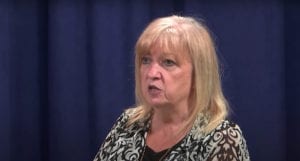Who is a member?
Our members are the local governments of Massachusetts and their elected and appointed leadership.

Elayna O’Neil, 66, shares the emotional and physical impacts she still experiences following a 45-day hospital stay in May.
Even after more than 200,000 deaths in the U.S. over six months, some continue to wonder aloud if COVID-19 is really as bad as public health officials make it out to be.
The city of Revere – among the state’s hardest-hit communities – decided to address these questions head on, launching a video project this fall called “Revere COVID-19 Stories,” featuring the sometimes-harrowing real-life experiences of survivors.
Elayna O’Neil, 66, shares the emotional and physical impacts she still experiences following a 45-day hospital stay in May. Marvin Pena, a 35-year-old marathon runner who spent five weeks in intensive care and 23 days in a coma, talks about the impacts of the illness on his small business. Sara Restrepo, a professional singer, talks about her three trips to the hospital to be put on oxygen and how her husband also got the virus. Britney Sao, 19, who contracted the virus along with her parents, talks about the 45 days her father spent in the ICU.
The growing collection of four- to 16-minute vignettes – with one in Spanish – is designed to combat skepticism and curb the spread. The stories, told to and aired by Revere TV, the city’s cable access channel, are aimed at ending debate about the disease’s virulence and encouraging people to adhere to public health protocols.
A densely populated city of 54,000 just north of Boston, Revere led the state in late July, with a COVID testing positivity rate of 6.25%, and remains a hot spot.
“Earlier this spring, I was driving down Revere Beach Boulevard with a bullhorn,” Mayor Brian Arrigo said. “We’re really just trying to use every resource we have to get the point across that this is real, it’s impacting our city, and it’s probably not going away anytime soon.”
“My feeling through all of this is that I know people are tired of hearing from me,” he said. “They want to hear from people who are their neighbors.”
Arrigo and Revere TV Executive Director Robert Dunbar said feedback on social media and around town has been positive since the first four stories went live in September.
“The people who ended up showcasing their stories were cultivated through relationships in the community and our contract tracing team,” Arrigo said, noting that credit for the storytelling platform idea and efforts to recruit participants goes to Revere’s Emergency Response Team. “I’m really grateful to people being willing to share their stories.”
Efforts are underway to spotlight additional survivors’ stories in the weeks ahead.
“As long as we have to tell these stories, we’re going to continue to do them,” Arrigo said. “With colder weather approaching … it’s really important for people to hear these stories, especially if we see cases starting to swipe back up again.”
The four residents’ stories are posted on Revere TV’s YouTube channel and air daily on community TV channels. The station and city are also sharing links to the video clips on social media.
Dunbar said he’s not aware of other local cable access stations doing similar projects, but he knows others in the region are considering it.
“Hopefully, there’s a growing interest to collect more of these throughout the region,” he said, noting that the project also has “historical value – a time capsule aspect to it.”
In tandem with the storytelling project, Revere TV has been working since the summer with a group of Revere High School students who interviewed people in the community about COVID-19.
“Even if it has an effect on two people or one person, that can have a larger effect on more people,” he said.
Written by Lisa Capone